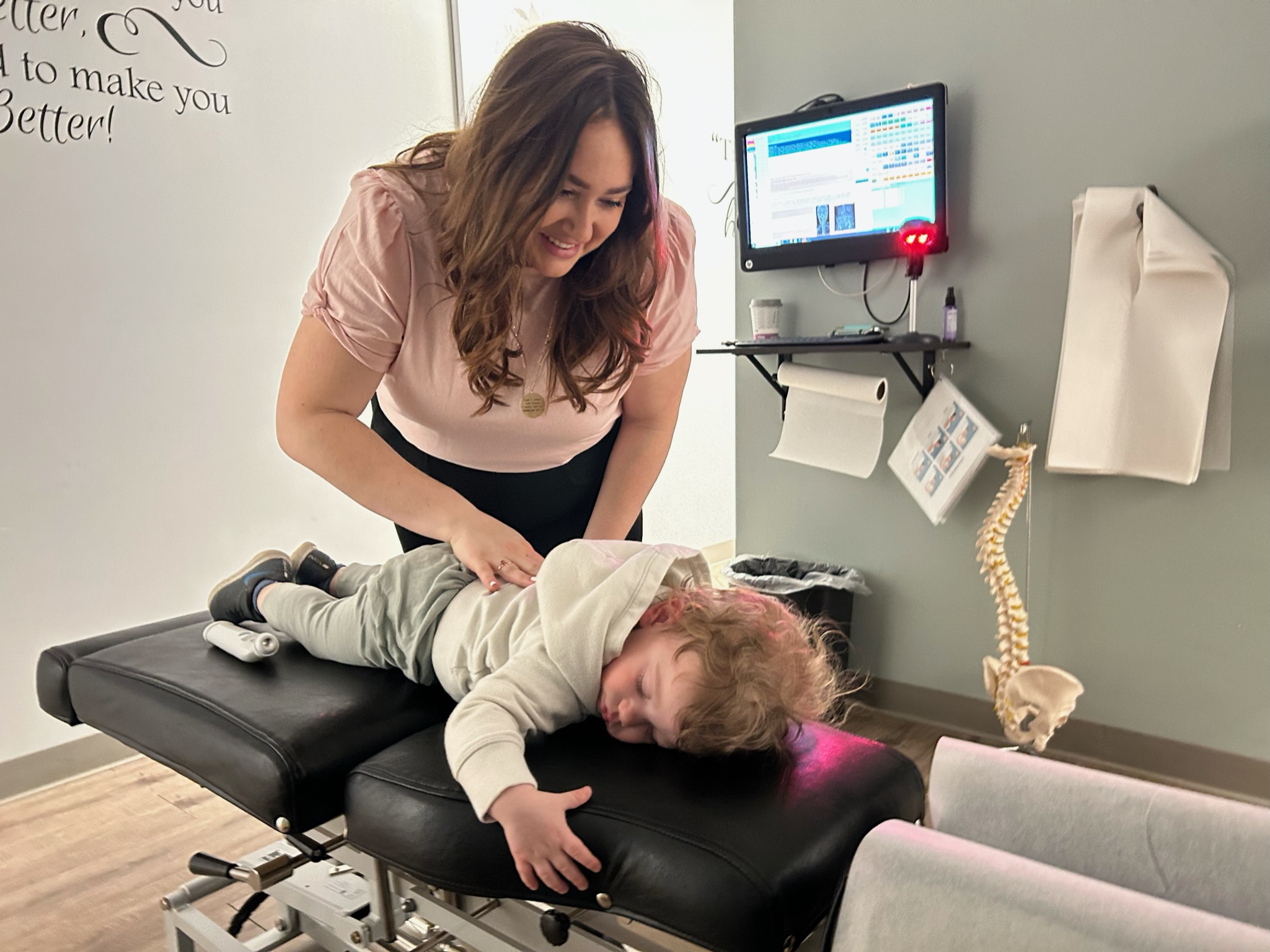We’ve previously talked about what chiropractic care can look like for both you and your family. Now that you know what chiropractic care IS, this post will clarify what chiropractic care is NOT.
Continue reading to break through common chiropractic myths and become more confident in choosing chiropractic care as an addition to your healthy lifestyle!
Myth #1: You can adjust yourself.
“I don’t need a chiropractor, I pop my own back!” While that popping sound may allow a sensation of relief (due to the release of happy hormones, i.e. endorphins), this does not address the true, underlying cause of your issue and many times can cause negative effects. That is truly all it is: a short-term release of pressure.
The sound you hear is gas releasing from the joint space between two spinal bones. Let’s envision three bones in the back. The one in the middle is the “stuck” one–the bone that is not moving as it should (it is subluxated). Without a specific force given by a trained Doctor of Chiropractic into that one bone, the already “unstuck” bones above and below are the ones to move.
With excess movement, and continuous “self-popping,” those bones become hypermobile. This is why if someone starts to pop their own spine, they feel the need to chase that release more and more often. This repetitive, unspecific popping is actually dangerous, leading to ligament laxity and possibly damage to those tissues in the future.
Chiropractors don’t even adjust themselves, so neither should you! All three of us doctors at Essential Family Chiropractic are checked for subluxation (spinal bone misalignment causing brain-body miscommunication) a minimum of once per week.
Myth #2: Once you start at the chiropractor, you have to go for the rest of your life.
You might have a friend or family member who says on repeat, “I love chiropractic, I will definitely go for the rest of my life!” A lifetime commitment is a reasonable apprehension to have, especially when we limit chiropractic care to only aches and pains. At Essential Family Chiropractic, we look deeper and care for the entirety of the patient. Our chiropractic advocates know they not only feel better, but they function better, too, through consistent chiropractic care!
We understand the hesitation. But our question to you is this: do we achieve physical goals at the gym, and then stop moving our bodies? No! Our body craves movement, and it is necessary to maintain our physical goals. How about dentist appointments? You have no cavities at your regular check-up. Yay! So you stop brushing your teeth, right? Absolutely not. Dental care is vital to optimal health, but the bones that house your nervous system are arguably even more important. Unfortunately, our spinal health is easier to overlook, as we cannot visibly see our spine without an x-ray.
The fact is, your spine houses your nervous system–the system that controls and coordinates ALL communication from your brain to the rest of your body. Bodily functions begin to suffer when we have miscommunication. For some, bladder control weakens, leading to bedwetting or incontinence. Others experience poor sleep, weakness of muscles leading to fast fatigue, or constipation.
When we think about the deterioration of our teeth, those problems make themselves well-known early on, with small cavities, before larger issues of root decay set in. This is why dental check-ups are recommended every six months, for a deep cleaning. We prioritize preventative care by flossing and brushing multiple times per day. Why don’t we think about our spinal health in the same way?
Before there is a major issue–leading to spinal surgery–let’s take care of those daily stressors to help your body better adapt and grow stronger. This is why you have loved ones who go to a chiropractor regularly. They understand Benjamin Franklin’s words: “An ounce of prevention is worth a pound of cure.” If we don’t invest in maintenance now, we could suffer with the negative consequences in the future.
Myth #3: Chiropractors aren’t “real” doctors.
We appreciate the chance to share all it takes to become a Doctor of Chiropractic! A bachelor’s degree is needed before beginning chiropractic college in most states in the U.S. We then enter our doctorate program (another roughly four years). After, we work in an office setting, similar to a residency program.
In the beginning of chiropractic college, our course load is very similar to that of medical school–we both take classes in basic sciences, embryology, osteology, anatomy and physiology, clinical diagnosis, radiology, and toxicology. Then, our schooling becomes specialized towards our expertise in health care. Chiropractors focus on the body from a holistic viewpoint, including an in-depth education on chiropractic techniques and philosophy. Medical doctors focus on pharmacology, medication, and the various interactions in the body.
To be licensed as a Doctor of Chiropractic in the state of Michigan, we are required to pass all four parts of the National Board, which includes all the basic and clinical sciences, nutrition, orthopedic and radiological diagnostics, and adjusting techniques. Many states also require the Physical Therapy National Board.
Whew! We go through a lot of education so we can provide an adjustment to you and your family. Us doctors at Essential Family Chiropractic did not stop there with our education, though. We all have a heartbeat to care for kiddos and pregnant mamas. Therefore, we have additional training and certifications through the International Chiropractic Pediatric Association. Our doctors also choose to attend multiple seminars each year to fine tune and even learn new adjusting skills. At Essential Family Chiropractic, we are life-long students!
Myth #4: “Chiropractic doesn’t work,” or, “I don’t believe in chiropractic.”
Chiropractic is not a religion; you don’t have to “believe” in it. Okay, all joking aside, this is something we hear often. The person saying it typically has a personal reason for not “believing.” We want to hear them out and ask clarifying questions. Most of the time, when chiropractic “doesn’t work,” that person was not given a clear plan for their care by their past chiropractor, or they were told to come back only when it hurts again. This can feel very frustrating when the pain is like a roller coaster, always coming back at the worst times (typically with heightened life stress–no surprise!).
To that, we can put this person at ease. After we gain all the clinical information about their current health, their health history, neurological scans, and x-rays when necessary, we can give very specific recommendations on how often we need to see them to allow for the best healing in their body. Sometimes the real issue is that they don’t want to commit to multiple visits. They want a “quick fix” for their issue that has been around for months or even years. While we have to assess in the office before we can assume any timeline of healing, with our expertise, we do know it takes more than one or two adjustments to see lasting change.
Have you ever gone to the gym once or twice and thought, “Wow, I don’t look any different than before I went the first time. I think I’m done.” To feel or see change in our physical bodies, it takes weeks or months of consistency. The same principle applies to chiropractic and life in general–all processes require time.
We invite you to give yourself some grace in this moment; healing takes TIME. Many people have spent years with a poorly moving spine and poorer communication between their brain and body. In the same way that it takes time to train your muscles to gain speed and strength, it takes time to train your nerves to regain proper communication!
Myth #5: Chiropractic care is unsafe.
In our office we adjust four generations of families; from hours old until their last moments on this earth, and everyone in between. Our adjusting styles and techniques allow us to adjust ANYONE’S spine safely and effectively. Newborn baby adjustments look different than a 23-year-old athlete’s adjustment, which looks a lot different than a 78-year-old with osteoporosis. We are aware that each body is different. Therefore, we take care of you based on your body.
We also set clear expectations for how you may feel after the adjustment. Often in the beginning of care, our patients will say how sore and achy they are, similar to a full body workout. Great! Your muscles are activating appropriately to hold your spinal bones back into proper alignment. Others who have had numbness in their limbs may start to experience “pins and needles” sensations, like when your foot starts to wake up after you’ve been sitting on it for too long. Your nerves are waking up and healing!
If we didn’t set those expectations up front, these uncomfortable symptoms would be worrisome. Our patients understand that these are healthy changes under our care. However, it is always best to check in with your chiropractor if you have any concerns after an adjustment.
An uncommon event, but something that tends to create a big headline, is “Chiropractic care causes stroke.” We can understand where this would cause hesitation for many, so let’s clear up the confusion! Many early symptoms of a stroke are also common reasons to consult a Doctor of Chiropractic. This is why we ask in-depth questions about your health history, perform neurological scans, and take x-rays before we ever place our hands on you for an adjustment. We are confirming that you are a candidate for chiropractic care. We are able to successfully co-manage with your medical doctor, when needed, as we understand there is a time and place for medical care.
In order for an adjustment to play a factor in a stroke, the practitioner would have to perform a non-specific manipulation that extends far beyond the normal ranges of motion in the neck. Simply put, our doctors at Essential Family Chiropractic NEVER do that adjustment, eliminating that risk completely. The likelihood that an individual has a stroke after a visit to their chiropractor is the same likelihood that an individual has a stroke after a visit to their PCP, per this meta-analysis research performed by Harvard and Johns Hopkins, which concludes: “There is no convincing evidence to support a causal link, and unfounded belief in causation may have dire consequences.”













